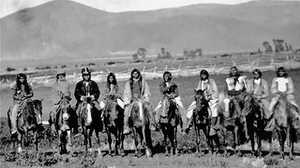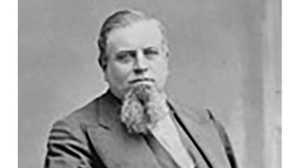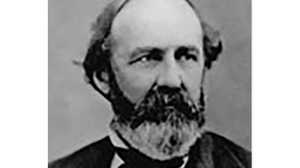Workers of the Central and Union Pacific Railroad

Workers of the Central Pacific Railroad:
Chinese peasants from the Canton Province began arriving on California's shores in 1850, pushed by poverty and overpopulation from their homeland — and pulled forward by rumors of the Gum Sham, the Mountain of Gold, that awaited them across the ocean. Initially, they took five-year stints in the mines, after which they prospected or accepted jobs as laborers, domestic workers, and fishermen. As their presence increased, the Chinese immigrants faced growing prejudice and an increasingly restrictive laws limiting opportunity. When Leland Stanford was elected governor of California in 1862, he promised in his inaugural address to protect the state from "the dregs of Asia." Stanford, at least, would change his tune.
Labor Shortage
In early 1865 the Central Pacific had work enough for 4,000 men. Yet contractor Charles Crocker barely managed to hold onto 800 laborers at any given time. Most of the early workers were Irish immigrants. Railroad work was hard, and management was chaotic, leading to a high attrition rate. The Central Pacific management puzzled over how it could attract and retain a work force up to the enormous task. In keeping with prejudices of the day, some Central Pacific officials believed that Irishmen were inclined to spend their wages on liquor, and that the Chinese were also unreliable. Yet, due to the critical shortage, Crocker suggested that reconsideration be given to hiring Chinese. He encountered strong prejudice from foreman James Harvey Strobridge.
Impressive Workers
Strobridge's attitude changed when a group of Irish laborers agitated over wages. Crocker told Strobridge to recruit some Chinese in their place. Instantly, the Irishmen abandoned their dispute. Sensing at least that fear of competition might motivate his men, Strobridge grudgingly agreed to hire 50 Chinese men as wagon-fillers. Their work ethic impressed him, and he hired more Chinese workers for more difficult tasks. Soon, labor recruiters were scouring California, and Crocker hired companies to advertise the work in China. The number of Chinese workers on CP payrolls began increasing by the shipload. Several thousand Chinese men had signed on by the end of that year; the number rose to a high of 12,000 in 1868, comprising at least 80% of the Central Pacific workforce. "Wherever we put them, we found them good," Crocker recalled, "and they worked themselves into our favor to such an extent that if we found we were in a hurry for a job of work, it was better to put Chinese on at once."
"Celestials"
The Chinese workers were punctual, willing, and well-behaved -- sometimes referred to as "Celestials" in reflection of their spiritual beliefs. They were quite unlike their Caucasian counterparts, who quickly resented the growing competition and harassed the foreigners. Crocker and Strobridge made clear to the Irishmen that they could work alongside the Chinese crews or be replaced by them. The ultimatum may not have cured the anger of the white crews, but it sufficed to quell rebellion.
Less Pay
The Chinese teams were organized into groups of 20 under one white foreman; as the difficulty of construction increased, so often did the size of the gangs. Initially, Chinese employees received wages of $27 and then $30 a month, minus the cost of food and board. In contrast, Irishmen were paid $35 per month, with board provided.
Healthier Habits
Workers lived in canvas camps alongside the grade. In the mountains, wooden bunkhouses protected them from the drifting snow, although these were often compromised by the elements. Each gang had a cook who purchased dried food from the Chinese districts of Sacramento and San Francisco to prepare on site. While Irish crews stuck to an unvarying menu of boiled food — beef & potatoes — the Chinese ate vegetables and seafood, and kept live pigs and chickens for weekend meals. To the dull palates of the Irishmen, the Chinese menu was a full-blown sensory assault. The newcomers seemed alien in other ways: they bathed themselves, washed their clothes, stayed away from whiskey. Instead of water they drank lukewarm tea, boiled in the mornings and dispensed to them throughout the day. In such a manner they avoided the dysentery that ravaged white crews.
A Famous Retort
As work crews approached the summit, Strobridge continued to doubt the suitability of Chinese to certain tasks. When a group of Irish masons struck for higher wages, Crocker suggested using Chinese men in their place. The foreman objected. Famously, Crocker replied, "Did they not build the Chinese Wall, the biggest piece of masonry in the world?" Strobridge acquiesced, and Chinese crews were soon laying stone.
The Ten-Mile Day
Toward the end of the line, Crocker was so convinced of the skill of his Irish and Chinese workers that he decided to try for a record by laying 10 miles of track in one day. April 28, 1868 was the appointed day, and Crocker had prepared well. "One by one, platform cars dumped their iron, two miles of material in each trainload, and teams of Irishmen fairly ran the five-hundred-pound rails and hardware forward," writes author David Bain. "Straighteners led the Chinese gangs shoving the rails in place and keeping them to gauge while spikers walked down the ties, each man driving one particular spike and not stopping for another, moving on to the next rail; levelers and fillers followed, raising ties where needed, shoveling dirt beneath, tamping and moving on...." Watching the scene was a team of soldiers. Its commander praised Crocker and his workers for their effort to lay so much rail in so little time. "Mr. Crocker, I never saw such organization as that; it was like an army marching over the ground and leaving a track built behind them."
Workers of the Union Pacific Railroad:
Construction got a slow start in Omaha, Nebraska, eastern terminus of the Union Pacific Railroad. By April 1864 the jubilance of groundbreaking had long ago faded into the ether. Chief engineer Peter Dey continued to suffer setbacks in putting together his stalled project. Chief among these was a dearth of labor. Neither Dey nor the firms he wanted to reward with construction contracts could find enough men for the massive job. "It is impossible to do anything in the way of letting this work now without some provision for furnishing men," the engineer wrote to railroad executive Thomas Durant, adding that some provision must be made toward importing an army of men. Durant in turn asked the War Department to ship Dey some portion of those slaves freed by the ongoing Civil War. The government declined. Union General Grenville Dodge offered use of Indian prisoners from his winter campaign. But no practical solutions were forthcoming. By the end of 1865, only 40 miles of track had been laid across the inviting valley.
Veterans for the Railroad's Ranks
The end of the Civil War brought a change of fortune for the Union Pacific. Thousands of demobilized soldiers were eager for work. Additionally, by 1866 the railroad had managed to import Irishmen from the teeming cities of the eastern seaboard. Suddenly swarms of men surrounded Dodge, who had replaced the frustrated Dey as chief engineer. Joining him that winter in Omaha was construction boss Jack Casement.
Military Precision
Working in tandem with his brother, Dan, former Brigadier General Jack ran his men with a military precision that hinged upon the efficient division of labor. Teamsters piloted small horse-drawn carts along freshly-laid track. Men on either side of those carts unloaded rails and moved forward to place them parallel to one another on embedded ties. Gaugers stepped in to ensure the rails were the correct distance apart. Bolters knelt down to join the contiguous rails on either side of the track. Spike men followed behind, dropping spikes onto the grade. Hammer-wielders picked up the spikes, tapped them gently into the ties, then with three heavy strokes of the sledgehammer drove them home, securing the rail to its bed. Teamsters drove their carts forward along the new track, and the whole process repeated itself again and again, an assembly line moving forward on the product it assembled. Behind the workers followed flat cars loaded with supplies, and behind those the portable bunkhouses in which workers resided. On average Casement's men finished nigh on two miles a day. On occasion General Jack was known to complete mind-boggling stretches of much greater length.
Working on the Railroad
Pay varied according to responsibility. Teamsters and graders received the least, while the iron men got the healthiest sum of anybody save their foremen. Like their Irish counterparts on the Central Pacific, the Union Pacific men had a staple diet of beef, bread, and black coffee. Water-borne illness was often a serious concern. Personal hygiene was all but unheard of. The men slept together on bunks in the rolling fortresses Casement had designed for them the previous winter. They were tight quarters in which conditions could be squalid. Also troubling were fears of the Native Americans across whose land the laborers built their road. There were Native American snipers, raids, livestock rustlings, scalpings, and burnings all along the railroad right of way. Indian sightings sufficed to spook men, and line surveyors did not always return from their routes. News of the slaughter of troops at Fort Philip Kearny on December 21, 1866, "the Fetterman Massacre," was enough to convince many a worker there were better ways to earn a living.
Hell on Wheels
In the early days of construction there was little to keep the men entertained but liquor. Many attacked it with a passion. Purveyors of entertainment, including those who were in the business of selling vice, found a captive audience. As the railroad progressed westward, the phenomenon called Hell on Wheels followed in close pursuit -- saloons, gambling houses, and brothels opened their doors at the end-of-track towns that sprouted along the route, and prospered from the hard-earned cash of the Union Pacific laborers.







